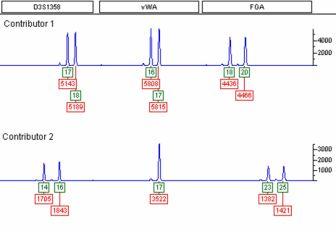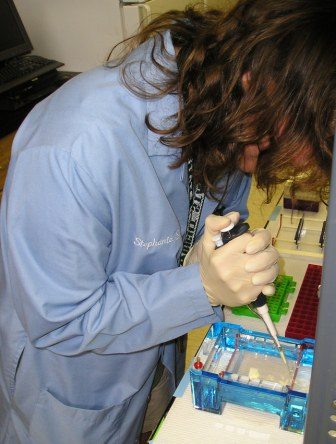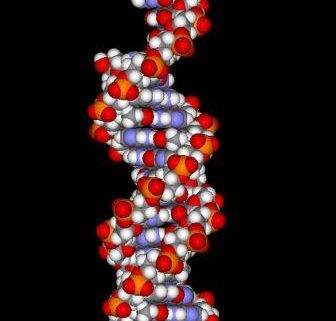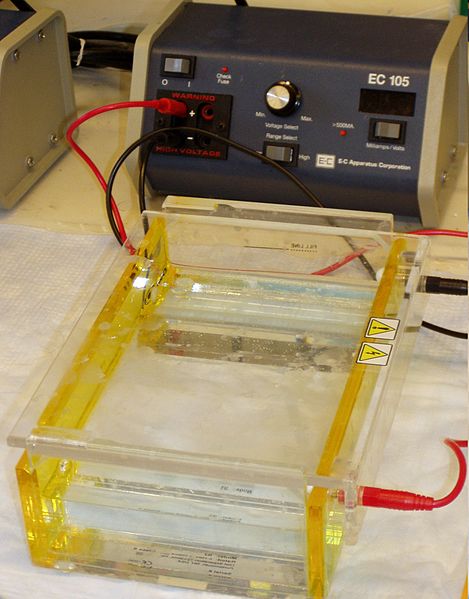Things Writers Should Know About DNA: An Encore
Sometimes, we just seem to get our tangs all tonguled up and use the wrong words in our stories. Perhaps we learned those incorrect little language units while watching television, or while reading a novel written by a die-hard CSI fan. Either way, here’s some words and facts about DNA that all writers should know if their stories involves this area of forensics.
Terminology
ABI 310 Genetic Analyzer – capillary electrophoresis instrument used in laboratories for DNA testing.
ABI 310 Genetic Analyzer
Allele – an alternate form of a gene, such as hair color and the shape of your nose.

ASCLD – American Society of Crime Lab Directors.
Autoradiogram – a sort of x-ray picture of where radioactive probes have adhered to alleles. (It’s a picture of someone’s DNA).
Band – a picture of a DNA fragment.

Capillary Electrophoresis – a method of separating DNA using straw-like capillaries.

The scientist is pointing to the eight capillaries.
Chromosome – a very large piece of DNA.

23 pairs of chromsomes. Males have one Y and one X chromosome. Females have two X chromosomes.
CODIS – Combined DNA Index system. Established in 1998.
Degradation – chemical or physical breakdown of DNA.
Electrophoresis – method of separating DNA molecules using an electric field.
Gel electrophoresis
Electropherogram – A plotted printout of DNA test results.

Gel – medium used in electrophoresis to separate DNA.

Loading DNA into gel.
Genome – an organism’s genetic composition.
Locus – Location of a gene on a chromosome. (pl. Loci)
Mitochondrial DNA – DNA transferred only from mother to child.
STR – repetition of four tandomly repeated nucleotides. The FBI typically uses 13 STR loci in forensic analysis.
DNA Facts:
Identical twins have identical DNA.
Humans are genetically 99.9% identical. Only 0.1% of our genetic makeup is different.
It takes about eight hours for one cell to copy its own DNA.
Red blood cells do not contain DNA.
DNA is used to determine pedigree in livestock.
DNA is used to authenticate wine and caviar.
Detergent and Alcohol will not destroy DNA.
DNA can be transferred from article of clothing to another, even in a washing machine. This is called secondary and tertiary transfer.
DNA testing is not 100% accurate.
Criminal cases involving DNA evidence are usually quite serious in nature (homicide, rape, etc.). Less than 1% of that DNA evidence is reviewed by defense attorneys.
*I’m traveling this week and my internet access is quite limited. I hope you enjoy these reflections of past Graveyard Shift shift posts. I’ll check in when I can.






Lee,
Something to add:
STR = short tandem repeats
Most states only require 8 loci to match to be considered a match and thus grant convictions. Also when doing a search, if you input say 9 loci into CODIS and there are 13 in CODIS, you may only get those that match the potential 9 loci. Potentially, if your suspect had his/her DNA profile run and entered with anything but 9 loci, you may NOT get their profile information at all.
Also, something to note, when comparing DNA for a capital crime, all loci must match. When comparing paternity, not all loci have to match. For example, a man could be tried for rape. His DNA might not match all of the loci of the sample taken from the victim, yet his DNA could be considered a match for the offspring developed by his attack. Legal technicalities… gotta love it.
Also, DNA is not an individual characterisic. It is a class characteristic. I see many authors get that wrong (and it makes me grind my teeth. LOL!) Fingerprints are an individual characteristic. Genetically identical twins will not share fingerprint patterns but will share all DNA loci. That is because fingerprint ridge detail is formed due to pressure on the amneonic fluid in the womb.
Just so you know, the AB 310 is commonly used in the field. We have two at Guilford. 😀
Lisa P